#Yousef Masoud
Text

This is one I missed earlier, it's from 19:10pm GMT on the 9th of November 2023, so almost 2 hours ago
This is DEEPLY fucking concerning. It also explains the earlier report about Reuters denying they had prior knowledge too. I can see them using this as 'justifiable cause' for targeting journalists.
In the way they claim Hamas is in every mosque, ambulance, portaloo, I'm waiting for them to start saying the journalists they murder were ones who recorded footage from the 7th.
#free gaza#free palestine#gaza strip#irish solidarity with palestine#palestine#gaza#news on gaza#al jazeera#boycott israel#israel#Journalism#Danny Danon#Reuters#Associated Press#CNN#Yousef Masoud#New York Times#Colonialism
8K notes
·
View notes
Text
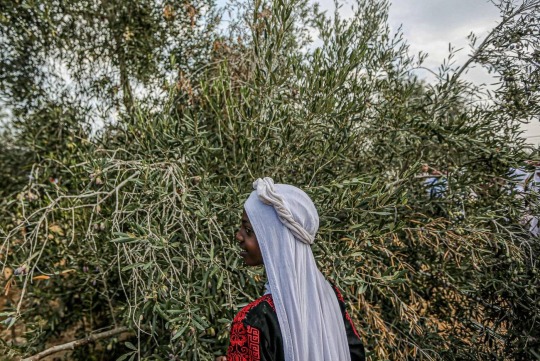
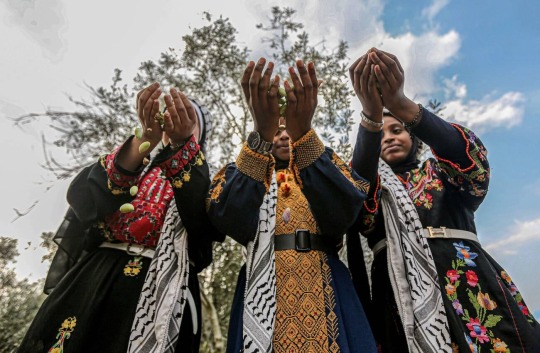

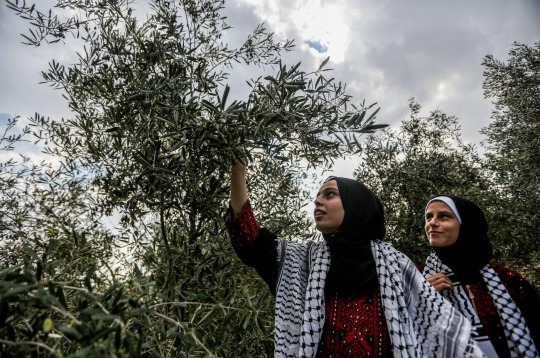

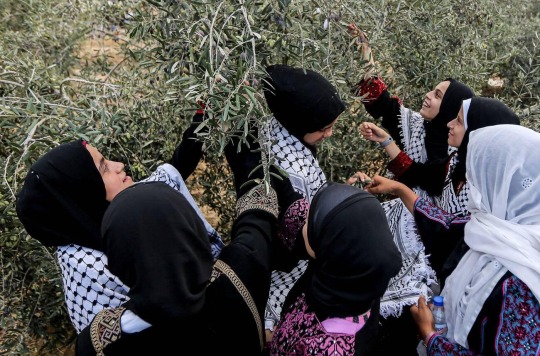
“Palestinian girls wearing traditional Palestinian clothes participate in the olive harvest season on a farm in Deir al Balah in the central Gaza Strip.”
October 23rd, 2022.
Photographed by Yousef Masoud.
4K notes
·
View notes
Text
By Brent Scher
A Jewish advocacy group filed a lawsuit on Wednesday charging the Associated Press with “material support of terrorism,” asserting that the news wire made payments to known agents of Hamas.
The National Jewish Advocacy Center asserts that on and after October 7, the date of the Hamas massacre of over 1,200 Israelis, the AP paid for real-time images of the attacks being carried out by photographers who are “known associates” of the terrorist group. Included in the group of images were scenes of Israeli hostages being transported into Gaza, where many of them have since been killed.
“AP’s website gave credit to photographers Hassan Eslaiah, Yousef Masoud, Ali Mahmud and Hatem Ali, for taking photographs of the massacre inside of the State of Israel,” the federal lawsuit filed on behalf of the group by attorneys including David Schoen asserts. “These photojournalists are known Hamas associates who were gleefully embedded with the Hamas terrorists during the October 7th attacks, and who sometimes worked for AP.”
“Upon information and belief, AP paid for the real time images of Israeli hostages being taken into Gaza despite having been warned well in advance that at least one of these so-called ‘journalists’ were in fact Hamas affiliates, and despite the clear indications that they were functioning as full participants of the Hamas terrorist squad that conducted the October 7th attack, and not as AP chose to pretend as journalists,” it continues.
#national jewish advocacy center#ap#associated press#hassan eslaiah#yousef masoud#ale mahmud#hatem ali#hamas#gaza
46 notes
·
View notes
Text
by Simon Plosker
HonestReporting’s expose on the Gaza photojournalists who infiltrated Israel on October 7 has caught the attention of the global media. As the story spread, however, so did the pushback, including attacks on HonestReporting’s integrity and various charges from some of the media outlets we’d asked questions of.
But first, some background. It’s no secret that there are some very bad actors within the Palestinian media community. In 2022, HonestReporting’s investigative work exposed several journalists covering the Israeli-Palestinian conflict as being virulent and unapologetic antisemites. As a result of our reporting, several mainstream media outlets decided to cut ties with them, at least indicating that there are red lines when it comes to media ethics and morality.
Which was the point of our most recent story. We set out to shine a light on the conversation surrounding the media’s use of Palestinian stringers who, at best, operate in an environment controlled by Hamas, and at worst, are active accomplices.
And we did it not only in our role as a media monitoring organization. We approached it as Israelis. As Jews. As human beings. Because it’s impossible to separate anything from the horrific events of October 7, which appear to have faded so rapidly from the collective memory of the outside world and the media. For Israelis, October 7 is an open and gaping wound. Which is why, when we looked at photographs on an Associated Press carousel embedded in an online story last week, we were horrified and disgusted.
Horrified to see images of a burning Israeli tank on the Israeli side of a border that had been breached by Hamas terrorists and, as it turned out, many “fellow travelers” who accompanied them. Disgusted to see that some of these images, including at least one of the body of German-Israel Shani Louk lying in the back of a truck, were attributed to Gaza photojournalists who were paid by media outlets for their images — images that could only have been captured inside Israel as the massacre was taking place.
There were so many unanswered questions and we decided to put them into the public sphere.
The Media Fire Back
The reaction was swift. More damning evidence started to emerge, particularly concerning Hassan Eslaiah, one of the four Gaza photojournalists we’d flagged as being inside Israel. AP and CNN took steps to sever ties with him.
All of the media outlets involved — AP, CNN, Reuters and the New York Times — publicly stated they had no prior knowledge of what was to occur on the morning of October 7. HonestReporting had not, however, accused any of those outlets of such an incomprehensibly appalling crime.
The New York Times doubled down in its backing of freelancer Yousef Masoud. Further question marks remain over Masoud’s explanation that he’d been woken up at 5.30 am by rocket fire even though the firing only started an hour later. This is unsurprising, given their backing of a decision to rehire Gazan freelance filmmaker Soliman Hijjy despite HonestReporting previously revealing how he had praised Hitler on social media.
#honest reporting#media bias#hassan eslaiah#gaza photojournalists#ap#cnn#reuters#new york times#october 7#yousef masoud
16 notes
·
View notes
Text
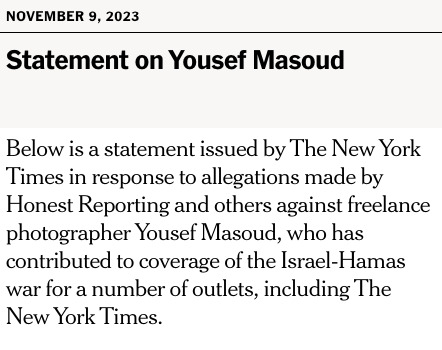
#the new york times#yousef masoud#israel#zionism#first the stupid pallywood conspiracy and now this attack on freelance journalists#like israel was warned(by its ally) that something was coming and they ignored it
0 notes
Text
Rafah is currently under bombardment, so I will spreading as much links as I can possibly can. If I miss any, please add on if you can
Help Mayar and her family
Help Nour
Help Marah Owda escape Gaza
Help Sobhe and his family escape Gaza
Help Razan and family escape from Gaza
Help Ahmed’s family escape Gaza
Help the Zamli family evacuate
Help this handicapped child escape Gaza
Help this family get out of Gaza
Help this family evacuate
Help Salah’s family
Help evacuate this family to safety
Help this family survive
Help Zayn’s family
Help Mohammed’s family
Help Abdullah Salem’s family
Help Dalia Masoud and her family
Help Mahmoud’s family
Help Eyad’s family
Help Osama’s family evacuate
Help Dr. Abdelwahab and his family
Help this displaced family
Help Abood and his family leave Gaza
Help Lara Sharif evacuate her family to safety
Help secure this family
Help Muhammed evacuate his family
Help Walid and family escape
Help Sarah Aljamal and her family
Help Walaa and her family evacuate from Gaza
Help Aya evacuate her sick mother from Gaza
Help Mohamed Zaqout’s brother escape Gaza
Help Bayan Meghari and her family
Help evacuate this injured father out of Gaza
Help Hossam and his family
Help evacuate the Abu Halabia family
Help treat Mulataf who has brain disease
Help a family of 7 evacuate Gaza
Help this child with cerebral palsy evacuate
Help Abdalla Mughari and his family
Help the Alashi family
Help Ghadeer Saeed’s family
Help Yousef and Khaled Al-Sultan’s family
Help Firas protect his family
Help Moneer and his family
Help Aya Adham get treatment for her hematoma
Links masterpost 1
Links masterpost 2
Links masterpost 3
Links masterpost 4
Please keep Palestine in your minds tonight and onwards even with distractions like the Oscars, helping the people is more important
#Sumechiaspeaks#Palestine#Gaza#Free palestine#viva palestina#mutual aid#Aid#Signal boost#Boost#Gofundme#Donations#Donation#all eyes on rafah#free gaza#Rafah
18K notes
·
View notes
Text

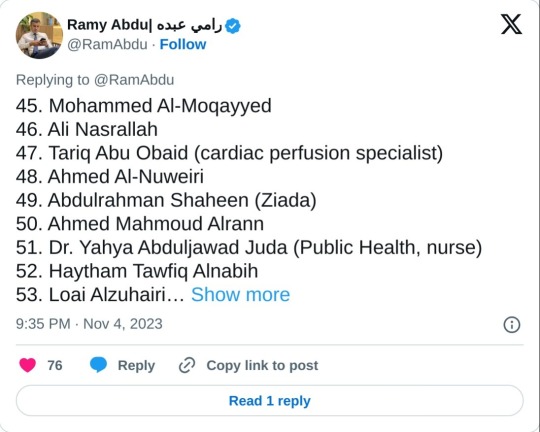
List of healthcare workers killed by Israel attacks on Gaza since October 7, 2023
Physicians:
Dr. Omar Ferwana, a Professor and former Dean of the Islamic University of Gaza Medical School and an andrologist, Gaza
Dr. Aya Ferwana (Dr Omar Ferwana’s daughter), a family medicine specialist, Gaza
Dr. Medhat Saidam, a senior burn and plastic surgeon, Shifa Hospital, Gaza and MSc in Burn Care alumnus from Queen Mary University of London
Dr. Mohammed Dabour, a consultant pathologist and dean of pre-clinical medicine at the Islamic University of Gaza Medical School
Dr. Tamer Al-Khayyat, an anesthesiologist and intensivist, European Gaza Hosptial, Rafah
Dr. Mahmoud Al-Khayyat, an internist in Rafah and Dr Tamer Al-Khayyat’s father
Dr. Razan Al-Rakhawi (Dr Tamer Al-Khayyat’s wife), an obstetric and gynecologist, Emirati Women’s Hospital, Rafah
Dr. Sereen Al-Attar a consultant obstetric and gynecologist at Nasser Hospital, Khan Younis and an Assistant Professor at the Islamic University of Gaza Medical school
Dr. Saeed Drabieh, a urology resident, Shifa Hospital
Dr. Mohammed Al-Samarai, Iraqi volunteer intern physician
Dr. Rafat Abou Foul, radiologist, Beit Hanoun Hospital
Dr. Amal Al-Maqadma, family medicine specialist, Rafah
Dr. Ibtihal Al-Astal, intern doctor, Khan Younis
Dr. Duaa Awad, emergency medicine doctor, Al-Aqsa Hospital
Dr. Moath Nabaheen, emergency medicine doctor, Al-Aqsa Hospital
Dr. Youssef Jadallah, intensivist and anesthesiologist (based in Germany, from Gaza but was visiting his family)
Dr. Inas Yousef, emergency medicine doctor, Al-Aqsa Hospital
Dr. Israa Al-Ashqar, anesthesiology resident, Shifa Hospital, Gaza
Dr. Abdallah Ashour, emergency medicine doctor, Nasser Hospital, Khan Younis
Dr. Hamam El-Deeb, orthopaedic surgery resident, Shifa Hospital, Gaza
Dr. Munther Abu Sariya, consultant pediatrician, Mohammed Al-Durra Pediatric Hospital
Dr. Doaa Shammout, pediatric resident, Rantisi Hospital, Gaza
Dr. Baraa Abu Elaish, intern doctor, Gaza
Dr. Abdlallah El-Helou, general practitioner/internal medicine doctor, Indonesian/Beit Hanoun Hospital
Dr. Muhannad Ezzo Afana, general practitioner, Gaza
Dr. Mohammed Refaat Mekki,
Dentists:
Dr. Ahmed Al-Hourani
Dr. Nada Mahdi
Dr. Ibrahim Al-Dali
Dr. Bilal Lubbad
Dr. Marwa Swelim
Dr Areej Eid
Dr. Tawfiq Al-Farra
Dr. Abdallah Baghdadi
Dr. Jameel Tarazi
Dr. Maysoon Al-Nuweiri
Dr. Mona Dughmush
Dr. Noha Dughmush
Dr. Mamoun Afana
Dr. Mohammed Afana
Dr. Anis Mekki
Dr. Tasneem Abdulnabi
Medical/dental students:
Bisan Halasa
Shaimaa Saydam
Abedelrahman Abu Shammala
Nour Al-Ashqar
Yaseen Al-Akhras
Osama Abu Safia
Duha Dughmush
Haneen Al-Shannat
Abdallah Abu Jayab
Zainab Azzam
Mohammed Abu Jiadan
Medical Scientists:
Prof. Salah El-Din Zanoun
Prof. Ahmed Al-Dalo
Prof. Ameed Mushtaha (Head of laboratories department and blood banks
Nurses:
Mohammed Lubbad
Mohammed Al-Azzaiza
Ahmed Moshtaha
Rami Lubbad
Somaya Temraz
Mohammed Rafat Gomaa
Osama A'eed Abu Safiya
Saber Al-Nimnim
Mohammed Hamad
Mohammed Al-Baz
Suleiman Abu Zour
Badr Mohammed Abu Daqah
Shaimaa Rayan (Midwife)
Maryam Abou Daher
Kefah San’allah
Walaa Adwan (Midwife)
Rawaa Al-Thalathini (Midwife)
Samah Rasheed (Midwife)
Rida Al-Masri (Midwife)
Ibrahim Abou Isaac
Amjad Abou Ouda
Ibrahim Al-Farra
Aya Al-Shrafi
Tamer Al Efesh
Momen Mansour
Asmaa Al-Asar
Feras Ftaiha
Diaa Bardaweel
Rana Shalaby
Itemad Miqdad
Zainab Al-Sharafi
Hamdan Malaka
Suheer Jbara
Hassan Al-Hennawi
Sabha Al-Sherafi
Azmi Al-Jamal
Yousef Al-Shareef
Hadeel Fanqa
Emad Esleem
Enas Al-Zeen
Heba Salamah
Nuha Esleem
Amro Masoud
Hanya Qudaih
Mohammed Al-Moqayyed
Ali Nasrallah
Tariq Abu Obaid (cardiac perfusion specialist)
Ahmed Al-Nuweiri
Abdulrahman Shaheen (Ziada)
Ahmed Mahmoud Alrann
Dr. Yahya Abduljawad Juda (Public Health, nurse)
Haytham Tawfiq Alnabih
Loai Alzuhairi (Nursing student)
Saleem Abu Zour
Waleed ElMahalawi
Rola Althalathini (Midwife)
Duaa Ashour
Amer Elramlawi
Safa Zeino
Saja Doghmosh
Moayad Ezzo Afana
Ramadan Doghmosh
Moemen Arab (Nursing student)
Oun Nofal Ashour (Nursing student)
Paramedics (EMS providers):
Marwan Abou Raida
Hatem Awad
Khalil Al-Sharif
Ahmed Al-Dahman
Yousri Al-Masri
Ahmed Abdel Rahman
Mohammed Al-Ghaliz
Mohammed Ali
Iyad Salim
Abdelrahim Abou Baid
Alaa Abou Ghanima
Naji Al Fayoumi
Mohammed Qateet
Tareq Ashour
Mahmoud Abou Mashayekh
Nafeth Al-Natour
Mahmoud Othman
Mohammed ElOmour
Ibrahim Matar
Yasser Alnaseri
Physiotherapists:
Ahmed Al-Masri
Ahmed Sameh Abou Herbeed
Shaimaa Sbaih
Mayar Al-Wahidi
Ahmed Ashraf
Shahrazad Al-Akhras
Nour Ibrahim
Pharmacists:
Ahmed Al-Jerjawi
Aziz Elfarra
Afnan Al-Astal
Shereen Abou Jazar
Eman Abu Al-Jalil
Safaa Hasouna
Ibraheem Meqdad
Mohammed Ali
Maysaa Khader
Nisreen Al-Dammagh
Sally Al-Aydi (Pharmacy student at AlAzhar University)
Mohammed Al-Shannat
Lina Abu Mualaileq
Noor Ibean
Haneen Albasyouni
Amira Dahman
Rawand Albanna
Khaled Abu Ma’ala
Amal Mekki
Abdullah Altartori (Pharmacy student at AlAzhar University)
Asmaa Abu Salah (Pharmacy student at AlAzhar University)
Mohammad Alshami
Lab technicians/clinical microbiologists:
Natheer Shaban
Asmaa Hijazi
Rawan Yassin
Alia Al Hinnawi
Maryam Kabaja
Nahid Abdullatef
Mohammed Abu Karsh
Mohammed Shabaan
Riham Elkahlout
Ismail Sharaf
Taiseer Alghouti
Abdulmohsin Abu Alrous
Duaa Jad Allah
Optometrists:
Omar Khorsheed
36 notes
·
View notes
Text
This can't be acceptable. Stop it!

Photo - Yousef Masoud for The New York Times
"According to the U.N. agency for children's welfare...since Oct. 7, UNICEF said in a statement, 2,360 children in Gaza and more than 30 children in Israel had been killed"
25 notes
·
View notes
Text
Bilder und Terror
Unter anderem gibt es die These, dass sich der Terrorakt dadurch auszeichnet, auch ein Bildakt zu sein. Gewalt, die gezeigt wird und deren Bild noch einmal sprengt, was ein Mord sein soll, das soll Terror sein. Hassan Eslaiah, Yousef Masoud, Ali Mahmud und Hatem Ali haben am 7. Oktober Fotos gemacht, die u.a. über die Agentur ap veröffentlich wurden. Gegen alle vier läuft seit ungefähr Mitte November 2023 ein Verfahren bei der Bundesanwaltschaft. Nicht nur dieser Fall, jeder Fall wirft auch prinzipielle Frage auf. Extreme Fälle und Ausnahmefälle werfen auch Fragen für solche Fälle auf, die nicht extrem und keine Ausnahme sein sollen. Die Frage stellt sich also zum Beispiel nicht nur für die Fotografen, sondern auch für diejenigen, die die Fotos verbreiten, also die Agenturen, die Plattformen im Netz und die einzelnen User. Eine Frage auszuweiten soll die Antwort nicht verunmöglichen, das soll Antworten schärfen.
2 notes
·
View notes
Text
Article under the cut, including graphic images.

Khaled Joudeh, 9, mourning over the body of his baby sister, Misk, last month in Deir al Balah, Gaza. Credit...Samar Abu Elouf for The New York Times
Thousands of children have been killed in the enclave since the Israeli assault began, officials in Gaza say. The Israeli military says it takes “all feasible precautions” to avoid civilian deaths.
Barefoot and weeping, Khaled Joudeh, 9, hurried toward the dozens of bodies wrapped in white burial shrouds, blankets and rugs outside the overcrowded morgue.
“Where’s my mom?” he cried next to a photographer for The New York Times. “I want to see my mom.”
“Where is Khalil?” he continued, barely audible between sobs as he asked for his 12-year-old brother. A morgue worker opened a white shroud, so Khaled could kiss his brother one final time.
Then, he bid farewell to his 8-month-old sister. Another shroud was pulled back, revealing the blood-caked face of a baby, her strawberry-red hair matted down. Khaled broke into fresh sobs as he identified her to the hospital staff. Her name was Misk, Arabic for musk.
“Mama was so happy when she had you,” he whispered, gently touching her forehead, tears streaming down his face onto hers.
She was the joy of his family, relatives later said — after three boys, his parents were desperate for a girl. When she was born, they said, Khaled’s mother delighted in dressing Misk in frilly, colorful dresses, pinning her tiny curls in bright hair clips.

Misk Joudeh via Joudeh family
Through his tears, Khaled bid farewell to his mother, father, older brother and sister, their bodies lined up around him. Only Khaled and his younger brother, Tamer, 7, survived what relatives and local journalists said was an airstrike on Oct. 22 that toppled two buildings sheltering their extended family.
A total of 68 members of the Joudeh family were killed that day as they slept in their beds in Deir al Balah, in central Gaza, three of Khaled’s relatives recounted in separate interviews.
Several branches and generations of the Joudehs, a Palestinian family, had been huddling together before the strike, relatives said, including some who had fled northern Gaza, as Israel had ordered residents to do. The Israeli military said it could not address questions about a strike on the family.
In the end, members of the family were buried together, side by side in a long grave, relatives said, showing footage of the burial and sharing a picture of Misk before she was killed.
Gaza, the United Nations warns, has become “a graveyard for thousands of children.”
Determining the precise number of children killed in Gaza — in the midst of a fierce bombing campaign, with hospitals collapsing, children missing, bodies buried under rubble and neighborhoods in ruins — is a Sisyphean task. Health officials in Gaza say that 5,000 Palestinian children have been killed since the Israeli assault began, and possibly hundreds more. Many international officials and experts familiar with the way death tolls are compiled in the territory say the overall numbers are generally reliable.
If the figures are even close to accurate, far more children have been killed in Gaza in the past six weeks than the 2,985 children killed in the world’s major conflict zones combined — across two dozen countries — during all of last year, even with the war in Ukraine, according to U.N. tallies of verified deaths in armed conflict.
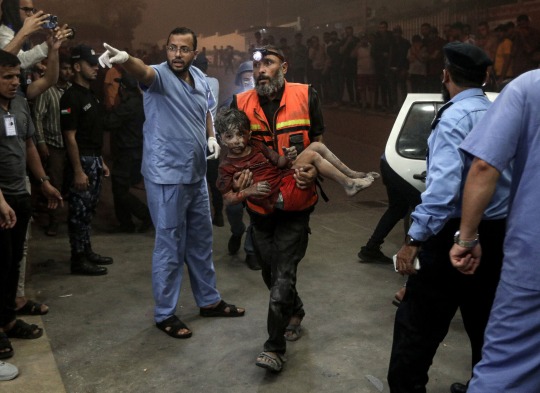
A wounded child arriving at Al-Nasr Hospital in Khan Younis, Gaza. Credit...Yousef Masoud for The New York Times

The body of a child pulled from rubble in Khan Younis. Credit...Yousef Masoud for The New York Times

The funeral of a child in Khan Younis on Oct. 26. Credit...Yousef Masoud for The New York Times
The Israeli military says that, unlike the “murderous assault against women, children, elderly and the disabled” by Hamas on Oct. 7, Israeli forces take “all feasible precautions” to “mitigate harm” to civilians.
Hamas, the military said, deliberately caused “the maximum amount of harm and brutality possible to civilians.” During the attack on Israel, parents and their children were gunned down inside their homes, witnesses and officials say, with children taken as hostages.
In response, the Israeli military says, it is waging a war “forcefully to dismantle Hamas military and administrative capabilities.” It notes that Israeli forces have told residents to flee to southern Gaza, and says that they issue warnings before airstrikes “when possible.”
But the furious pace of the strikes — more than 15,000 to date, according to the Israeli military, including in southern Gaza as well — makes the Israeli bombing campaign on the Palestinian territory one of the most intense of the 21st century. And it is happening in a dense urban enclave under siege with high concentrations of civilians, particularly children, setting off mounting global alarm, even from some of Israel’s closest allies.
After initially questioning the death toll reported by health officials in Gaza, the Biden administration now says that “far too many” Palestinians have been killed, conceding that the true figures for civilian casualties may be “even higher than are being cited.”
So many children are brought into the morgue at Al-Aqsa Hospital in Deir al Balah that the morgue director, Yassir Abu Amar, says he has to cut his burial shrouds into child-size fragments to handle the influx of corpses.
“The children’s bodies come to us broken and in pieces,” he said. “It’s chilling.”
“We’ve never seen this number of children killed,” he added. “We cry every day. Every day, we cry while we’re working to prepare the children.”
During previous wars, parents in Gaza, a crowded strip with more than two million people, sometimes put their children to bed in different rooms of their homes. If an airstrike damaged one part of the house, the other children might live.
Given the scale of the bombardment this time — which many Gazans describe as indiscriminate and without warning — some parents have put much greater distances between their children, splitting them up and sending them to relatives in different parts of the Gaza Strip to try to increase their odds of survival. Others have taken to scrawling names directly onto their children’s skin, in case they are lost, orphaned or killed and need to be identified.
In the emergency room of Al-Shifa Hospital in Gaza City, Dr. Ghassan Abu-Sittah said that many children had been brought in alone and in shock, with burns, shrapnel wounds or severe injuries from being crushed by rubble. In many cases, he said, no one knew who they were.

Waiting for treatment at Al-Shifa Hospital in Gaza City. Credit...Samar Abu Elouf for The New York Times

A wounded child was treated at Al-Aqsa Hospital in Deir al Balah. Credit...Samar Abu Elouf for The New York Times

Waiting for treatment at Al-Shifa Hospital in Gaza City. Credit...Samar Abu Elouf for The New York Times
“They are given a designation — ‘Unknown Trauma Child’ — until someone recognizes them,” he said. “The crippling thing is that some of them are the sole survivors of their family, so no one ever comes.”
“More and more, it seems like a war against children,” said Dr. Abu-Sittah.
Two weeks ago, the emergency room at Al-Shifa registered “Unknown Trauma Child 1,500,” Dr. Abu-Sittah said.
Then, in recent days, Israeli forces stormed the hospital, where thousands of Gazans had been sheltering, saying that the facility sat above an underground Hamas command center. United Nations officials warned that the raid put Gaza’s most vulnerable in even greater jeopardy.
International experts who have worked with health officials in Gaza during this and other wars say that hospitals and morgues in the enclave gather and report the names, ID numbers and other details of people who have been killed in the territory. While the experts urged caution around public statements about the specific number of people killed in a particular strike — especially in the immediate aftermath of a blast — they said the aggregate death tolls reported by health workers in Gaza have typically proven to be accurate.
The Israeli military says it “regrets any harm caused to civilians (especially children),” adding that it is examining “all its operations” to ensure that it follows its own rules and adheres to international law.
But a growing number of human rights groups and officials contend that Israel has already broken that law.
After condemning the “heinous, brutal and shocking” attacks by Hamas as war crimes, Volker Türk, the United Nations high commissioner for human rights, said this month, “The collective punishment by Israel of Palestinian civilians amounts also to a war crime, as does the unlawful forcible evacuation of civilians.”
“The massive bombardments by Israel have killed, maimed and injured in particular women and children,” he added. “All of this has an unbearable toll.”
Some international officials warn that children are in danger no matter where they go. “There is nowhere safe for Gaza’s one million children to turn,” said Catherine Russell, the director of UNICEF.
On Oct. 15, Dr. Mohammad Abu Moussa said that he was on a 24-hour shift at Al-Nasr Hospital in Khan Younis — south of the evacuation line drawn by Israel — when he heard a loud explosion nearby. He called his wife at home, but when she answered, he said, all he heard were screams.
Soon, he said, his wife, 12-year-old daughter and 9-year-old son were brought into the emergency room, bloodied, hysterical and covered in dust from rubble. He tried to comfort them, but panicked when he noticed that his youngest son, 7-year-old Yousef, was not with them.
“Where’s Yousef?” he recalled asking.
No one would answer.
When he pressed again about his son, he said a neighbor simply responded, “May God have mercy on his soul.”

Yousef Abu Moussa Credit...via Mohammad Abu Moussa
Dr. Abu Moussa didn’t want to believe it. Video from journalists at the hospital shows him frantically searching for Yousef. Dr. Abu Moussa recounted how he had asked other departments, including the intensive care unit, whether his son had been rushed there instead.
Then, he said, a journalist showed him pictures of their demolished home. Dr. Abu Moussa said he recognized the gray clothing Yousef had been wearing when he kissed him goodbye before leaving the house.
With dread, Dr. Abu Moussa walked from the emergency room to the hospital morgue. That’s where he said he finally found Yousef, a jokester with a cheeky smile who stuck out his tongue in photographs. Now, his lifeless body was lying on a gurney.
The shock was too much to bear. Dr. Abu Moussa recalled looking away before a colleague embraced him.
Multiple relatives said that airstrikes had hit their home without warning, and that Dr. Abu Moussa’s family had been pulled from the rubble. The Israeli military said it could not address questions about a strike on the family.
“Yousef was a very loved child,” said his mother, Rawan, a fitness instructor. “He was always smiling. He loved to laugh and make people laugh.”
At home, the boy had wanted to eat every meal next to his father, or in his lap, sometimes even sharing the same spoon.
“He would emulate me in everything I did,” Dr. Abu Moussa said, adding that his son had wanted to become a doctor as well.
Yousef was not the only one killed. Dr. Abu Moussa’s brother, Jasir Abu Moussa, lost both of his sons and his wife, family members said.
Dr. Abu Moussa’s nephew Hmaid, 18, had recently graduated from high school with high marks, the family said. He got his love of cars from his father and, from his mother, a love of poetry and art. He had hopes of studying mechanical engineering in Europe, relatives said, and had begun studying German even as he was studying for his high school exams.
His younger brother, Abdulrahman, 8, was even smarter, the family said. He was killed, too.
“He was a handful,” Jasir Abu Moussa said of his younger son. “But he was also very smart, and delightful.”
Death colors the living, as well.
Many children are showing clear signs of trauma, including night terrors, said Nida Zaeem, a mental health field officer with the International Committee of the Red Cross in Gaza.

Families in Khan Younis leaving their homes to seek shelter after an explosion. Credit...Yousef Masoud for The New York Times
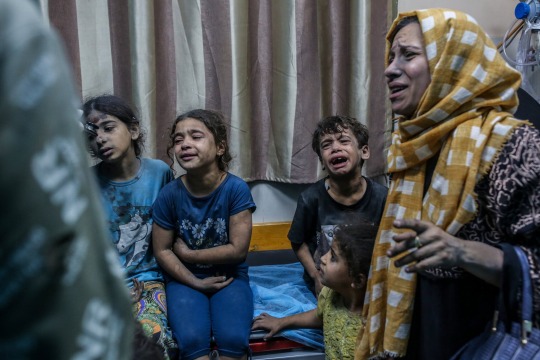
Wounded children in Khan Younis. Credit...Samar Abu Elouf for The New York Times

Children inspecting their family’s home after a blast in Gaza City. Credit...Samar Abu Elouf for The New York Times
“They are waking up shouting, screaming,” Ms. Zaeem said from a Red Cross shelter in Rafah, in the south, where she is staying with her family, including four children. Each night, she added, children in the shelter yell, “We’re going to die, we’re going to die.”
“They are shouting, pleading, ‘Please protect me, please, please hide me. I don’t want to die,’” she added.
In an encampment sheltering thousands of people around a United Nations center, Hammoud Qadada, 4, tried to focus on a video game inside a tent as the thundering sound of strikes were close enough to shake the ground beneath him.
When the soccer players on the screen scored, everyone in the tent — his siblings, cousins and other children from the makeshift encampment — yelled “goooaaal” so loudly that people in nearby tents thought a cease-fire had been announced.
Their parents had hooked up a television to a solar panel and, when it seemed safe enough, people played real soccer outside between the tents — trying to distract the children.
It wasn’t enough.
The next morning, Hammoud’s grandmother said he woke up and said, “I’m going to die.”
“I told him no,” said his grandmother Hanaan Jaber, 53. “God willing, you will grow up and you will get married and tell your children what happened with us here, like a story.”
Hammoud’s vocabulary has already been shaped by the war. Soon after it started, he asked his parents what “martyrdom” meant. When asked what is happening around him, he answers without hesitation: “Airstrikes. Airstrikes and war.”
Gaza, a coastal strip where cabanas and food shacks line the Mediterranean, once had a lively beach culture. Yasser Abou Ishaq, 34, recalled how he used to teach his three young daughters how to swim.
“They were always asking me to go to the beach, to the amusement park, to the parks,” he said. “I loved watching them play.”
Amal, his oldest, 7, was named after his mother. At school, she was a good student with excellent penmanship, he recalled. At home, she became the teacher who made her younger sister Israa, a 4-year-old who loved chocolate and Kinder toys, play along as the student.
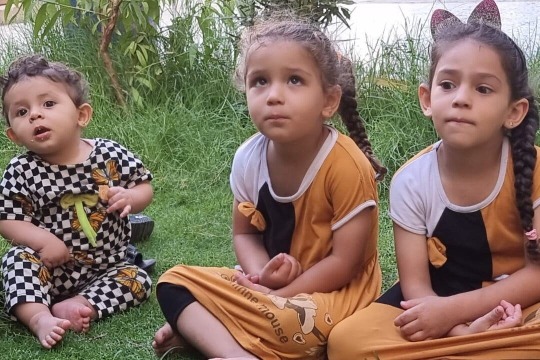
From left: Habiba Abou Ishaq, 1, and her sisters, Israa, 4, and Amal, 7. Credit...via Yasser Abou Isha
When his home was destroyed by what he said was an airstrike, he lost them both, he said. His wife was killed as well, he said.
In all, 25 members of his family, 15 of them children, have been killed, he said. Local journalists reported a strike and shared footage of bodies in burial shrouds — members of the Abou Ishaq family, they said — lined up on the ground as relatives cried over them. The Israeli military said it could not address questions about a strike on the family.
Mr. Abou Ishaq said that he and his 1-year-old daughter, Habiba, had been wounded and taken to the hospital. Most of his family, including his wife and Amal, were pulled from the rubble the same day and buried by relatives, he said, while he was still being treated. He never got the chance to say goodbye, he said.
The next day, Israa’s body was pulled from the rubble, he said. He was able to see her in the hospital’s morgue and hold her one last time.
“I hugged and kissed her. I said goodbye and I cried,” he said. “God only knows how much I cried.”

Mourning relatives outside the morgue of Al-Aqsa Hospital in Deir al Balah. Credit...Samar Abu Elouf for The New York Times
Reporting was contributed by Alan Yuhas, Samar Abu Elouf, Ameera Harouda and Abu Bakr Bashir
2 notes
·
View notes
Text

Palestinian rescuers at the scene of a destroyed building after an airstrike in Gaza City in October.
(Photo: Samar Abu Elouf for The New York Times)

Men using their bare hands to dig for victims in Khan Younis in November.
(Photo: Yousef Masoud for The New York Times)

Gathering at the scene of a building that was reduced to rubble after a strike in Gaza City this month.
(Photo: Agence France-Presse — Getty Images)

Removing the body of a child in Khan Younis in November. The dead are found days, weeks and even months after they were buried in the rubble.
(Photo: Yousef Masoud for The New York Times)

When a multistory building collapses, it is impossible to remove the hills of debris without heavy machines or fuel to power them.
(Photo: Agence France-Presse — Getty Images)
Gaza’s Shadow Death Toll: Bodies Buried Beneath the Rubble
With hand tools and bare hands, families and rescuers continue to search broken buildings for missing friends and relatives.
Gaza has become a 140-square-mile graveyard, each destroyed building another jagged tomb for those still buried within.
The most recent health ministry estimate for the number of people missing in Gaza is about 7,000. But that figure has not been updated since November 2023. Gaza and aid officials say thousands more have most likely been added to that toll in the weeks and months since then.
Some were buried too hastily to be counted. Others lie decomposing in the open, in places too dangerous to be reached, or have simply disappeared amid the fighting, the chaos and ongoing Israeli detentions.
The rest, in all likelihood, remain trapped under the rubble.
By Vivian Yee, Iyad Abuheweila, Abu Bakr Bashir and Ameera Harouda
The New York Times - March 23, 2024
•
#Middle East#Israeli-Palestinian conflict#Israel-Hamas war#Humanitarian crisis in Gaza#International calls for restraint#War crimes#Crimes against humanity#Human rights#Social justice#Ethics#Truth-telling#Israeli-Palestinian peace process#Gaza’s shadow death toll: bodies buried beneath the rubble
1 note
·
View note
Text
Antonio Velardo shares: As Gaza Losses Mount Under Strikes, Dignified Burials Are Another Casualty by Raja Abdulrahim, Samar Abu Elouf and Yousef Masoud
By Raja Abdulrahim, Samar Abu Elouf and Yousef Masoud
“The lucky are those who have someone to bury them when they die,” Dr. Mohammad Abu Moussa, a radiologist at one Gaza hospital, said of those killed by Israeli airstrikes.
Published: January 6, 2024 at 05:00AM
from NYT World https://ift.tt/M0bBxAi
via IFTTT
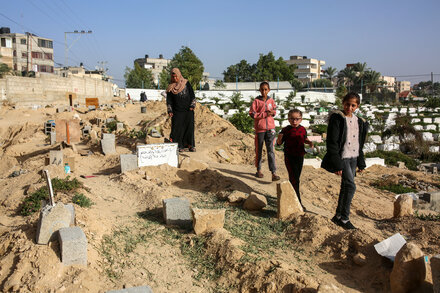
View On WordPress
0 notes
Text
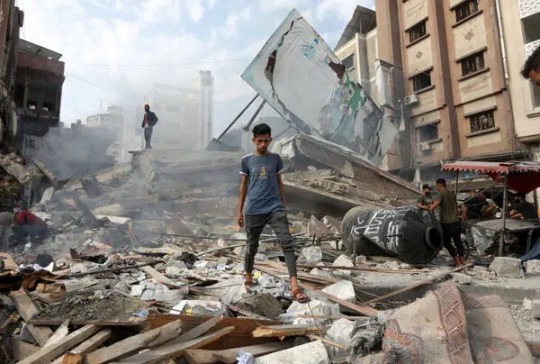
Hamas Wanted the War in the Holy City: Revelation 11 https://andrewtheprophetcom.wordpress.com/2023/11/15/hamas-wanted-the-war-in-the-holy-city-revelation-11/
0 notes
Text

ReduxStock: Photo by Yousef Masoud/The New York Times/Redux of a child being rushed to a hospital in Gaza, in Time magazine - November 20, 2023 issue.
0 notes
Text
The latest ghoulish development following the slaughter of 1,400 Jews in the Oct. 7 Israeli attack on Israel is quite a shocker.
The AP, CNN, Reuters, and The New York Times used footage and photos from reporters embedded with Hamas terrorists during their slaughter of hundreds of Jews.
These Western media outlets then posted the photos in their coverage of this horrendous surprise attack on Israel.
AP reporter Hassan Eslaiah took photos and video while traveling with Hamas killers during the massacre. Hassan also provided photos to CNN.
Yousef Masoud provided photos to The New York Times.
1 note
·
View note
Text
Hamas and Israel at war: what we know up until this point
Israel answers after Palestinian Islamist bunch dispatches shock assault and attack
Israel announces condition of battle after Hamas dispatches shock assault..
Palestinians wave their public banner on top of an Israeli tank east of Khan Younis line crossing. Photo: Yousef Masoud/AP
The Palestinian Islamist bunch Hamas has sent off an unexpected assault on Israel, its greatest in years.
We…

View On WordPress
0 notes